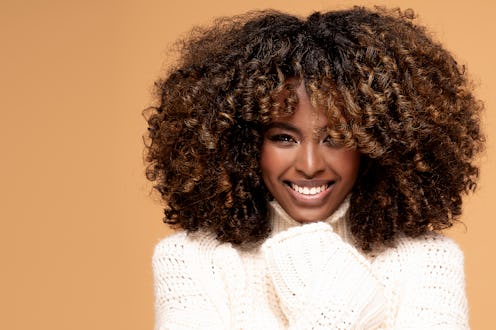Beauty
Everything You Need To Know About Plopping Your Hair
Zero heat styling required.

There are countless products and styling tools on the market that promise perfect bouncy curls. But you don't actually need to use much at all to achieve frizz-free tendrils, because once you learn how to plop hair, you can upgrade your curls by using just a cloth.
Hair plopping isn't new, but as people continue to seek out ways to care for their curls at home, this heat-free styling technique has resurfaced as one of the easiest ways to achieve beautiful ringlets. Seriously — it's so easy, and takes minimal time and effort with major payoff to not only your finished look but the health of your strands.
According to Garnier celebrity hairstylist Millie Morales, plopping works to dry hair using pieces of fabric — preferably a T-shirt or a towel — on wet hair. This method is great for all naturally curly hair types as well as for styling waves on straight hair.
To get all the intel on incorporating this easy styling technique into your hair care routine, Bustle spoke to experts — including Redken educator Blake Evans and hairstylist Anike Rabiu — to get their best tips on achieving heatless curls through hair plopping. Here's what you need to know.
How Do You Plop Hair?
The actual step-by-step of the process is quite simple. After following your normal wash and condition routine, detangle your hair to your liking. Then place your cloth on a flat surface and flip your hair forward, so it's upside down (carefully, of course, so you don't get your entire bathroom wet). Rabiu recommends allowing your hair to fall into the center of the towel before pulling the corners of the cloth towards the nape of your neck. You can secure it by tying it in a knot or using a hair tie to hold it in place. The next step is to wait; the length of time depends on your hair texture.
"For wavy hair to soft curls, wait 10 to 20 minutes," Evans tells Bustle. "For more defined curls and a thicker density, wait 20 to 30 minutes, and for 4C curls or chemically damaged hair try 30 minutes or sleeping in it overnight." As a pro tip, Evans also suggests starting with less time and adding more if you feel like you need your hair to dry a little bit more. "The goal is to get the drip out of hair so your curls can thrive in all their glory," he says.
While the drying time is important, the actual technique will also determine the outcome of your curls. "The higher you place your hair in relation to the towel or T-shirt, the more volume you’re likely to have once this experiment is complete," Rabiu tells Bustle.
If you have a protective style like box braids or twists, Rabiu says plopping will work to add a little curl at the end. To achieve this look, she recommends parting your hair into four sections and loosely twisting each from your scalp to the ends. Then dip each section into hot water to clean the braids and gently steam the scalp. "Take the four sections down one by one and sandwich each section with a towel or shirt to dry," she explains. Finish your styling by adding a mousse or leave-in conditioner (in spray form) and oil to the scalp to keep it frizz-free and moisturized.
What Are The Benefits?
The most obvious reason to choose this method is that it's heatless. According to studies, using thermal styling tools — like curling irons — that range between 130 and 170 degrees Celsius on your hair can result in significant damage to a variety of hair fiber types.
Besides avoiding heat damage, hair plopping can actually give you better looking curls. According to Evans, the drying period with the T-shirt or microfiber towel allows your waves or curls to dry in their natural state untouched by your hands, humidity, and the rough texture of traditional towels. "Your hair will have more volume and will have added definition," he says.
Does It Work For Everyone?
According to Evans, roughly 65% of people have some sort of texture to their hair, whether it's "wavy or zigzag curls," he says. That means hair plopping works for just about everyone, with just a few exceptions. "Anyone who wants to add more definition and volume to their texture should try this method," he tells Bustle. "Even if your hair is short and wavy, it works so well."
Rabiu, who often works with natural hair types, explains that the exception is for people with coarser textures. "I personally do not recommend [hair plopping] for high density, high porosity coily textures," she tells Bustle. "If your hair can’t lay on the towel, this technique is not for you." That's because it can lead to shrinkage or knots and tangles.
Studies referenced:
McMullen, Roger & Jachowicz, J. (1998). Thermal degradation of hair. I. Effect of curling irons. Journal of Cosmetic Science. https://www.researchgate.net/publication/289291195_Thermal_degradation_of_hair_I_Effect_of_curling_irons
This article was originally published on